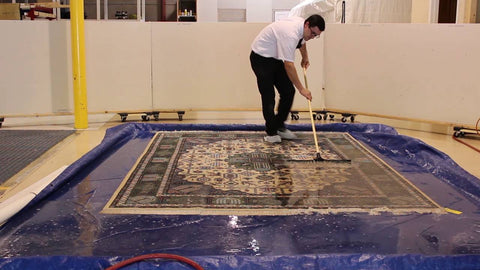How Should I Clean My Wool Rug to Maintain Its Quality?
1. Regular Maintenance: Vacuuming your wool rug at least once a week is crucial to remove surface dirt and debris. It’s important to use a vacuum without a beater bar or with a beater bar turned off, as these can agitate and damage the wool fibers. Instead, opt for an attachment designed for delicate surfaces which gently suctions dirt without pulling on the fibers.
2. Immediate Spot Cleaning: When dealing with spills, speed is of the essence. Blot any spills immediately with a clean, absorbent cloth. Press down firmly to absorb as much liquid as possible without rubbing, as this can cause the stain to set deeper into the fibers. For stains like wine or coffee, after blotting, you can use a mixture of water and mild detergent to dab the area gently. Always avoid harsh chemicals, as these can degrade the wool and strip away its natural oils.
3. Periodic Deep Cleaning: While regular vacuuming and immediate spot cleaning will address most of the care your wool rug needs, periodic deep cleaning is also necessary to manage dirt and allergens that accumulate over time. It is generally recommended to have wool rugs professionally cleaned every 12 to 18 months, depending on foot traffic and exposure to stains. Professional cleaners use methods and products that clean deeply without leaving residues or causing shrinkage.
4. Handling Moisture: Wool is highly absorbent, which means it can hold onto moisture. This can lead to problems like mold, mildew, or even fiber rot if not properly managed. After spot cleaning with water-based solutions, make sure the rug is dried thoroughly. You can elevate the cleaned area to increase air circulation or use a fan to speed up the drying process. Never use heat directly on a wool rug, as this can cause shrinkage and permanent damage to the fibers.
5. Avoiding Sunlight Damage: Wool rugs can also be susceptible to fading if exposed to direct sunlight over extended periods. If your rug is placed in a sunny spot, consider rotating it regularly to ensure even fading and reduce the risk of sun damage. Alternatively, use window treatments to limit the amount of UV light reaching the rug.

What Is the Best Method for Cleaning Synthetic Fiber Rugs?
1. Routine Cleaning Practices: Synthetic rugs are engineered to repel dirt and stains, making them easier to clean than most natural fiber rugs. Regular vacuuming is essential and should be performed two to three times a week depending on the rug's location and the level of foot traffic. Use a vacuum with adjustable suction to avoid damaging the fibers, especially on high-pile rugs.
2. Advanced Stain Removal: Due to their plastic-based fibers, synthetic rugs can handle water-based cleaning solutions better than natural fibers. For most spills and stains, a cleaning solution of mild detergent mixed with water is usually sufficient. Apply the cleaning solution using a spray bottle to avoid saturating the rug, then gently dab the stained area with a microfiber cloth or sponge, starting from the outside of the stain and moving inward to prevent spreading the stain further.
3. Specific Solutions for Synthetic Materials: One of the advantages of synthetic rugs is their resilience against chemical cleaners. For tougher stains, such as those from coffee or wine, you can use a stronger chemical cleaner like an enzyme-based cleaner, which breaks down stain molecules without damaging synthetic fibers. Always perform a spot test on a hidden section of the rug to ensure the cleaner does not affect the color or texture of the fibers.
4. Deodorizing and Freshening Up: Synthetic rugs can become odorous, especially in high-traffic areas. To deodorize, sprinkle baking soda over the rug, let it sit overnight, and vacuum it up the next day. Baking soda is a natural odor absorber and is safe to use on synthetic rugs. For a deeper refresh, a vinegar solution can help neutralize odors; mix one part white vinegar with three parts water and spritz lightly over the rug, allowing it to air dry.

Can Natural Fiber Rugs Be Cleaned at Home, and How?
Natural fiber rugs, such as those made from jute, sisal, and bamboo, offer an organic look and feel but can be tricky to maintain. These materials are less resistant to moisture and can be damaged by conventional cleaning methods. The best way to care for these rugs is to vacuum regularly with a suction-only vacuum, which prevents the fibers from fraying.
For cleaning spills, blot immediately with a dry cloth followed by a damp cloth. Avoid using too much water, as natural fibers are highly absorbent and can develop mold or mildew. If a deeper clean is necessary, use a dry extraction carpet cleaning method. This method is recommended by experts because it does not saturate the rug with water and effectively removes dirt without damaging the fibers.
Additional Tips to Remember
Rug Rotation: Regularly rotating your rug can prevent uneven wear and fading, especially in areas exposed to sunlight.
Professional Rug Cleaning: For deep cleaning, especially for delicate or high-value rugs, professional cleaning is recommended.
Rug Underlay: Using a rug pad can extend the life of your rug by cushioning the impact between foot traffic and the hard floor.
Rug Storage: When storing rugs, clean them first, roll them with the front side in, and wrap them in a breathable material to prevent dust accumulation and moisture damage.
Proper rug care involves more than just cleaning. It includes preventative measures and routine maintenance to ensure your rug remains a focal point in your home decor. For those interested in finding machine-washable rugs that offer both style and convenience, be sure to check out Adore Rugs’ collection of machine-washable rugs. With these tips and the right approach, your rugs can stay clean, vibrant, and functional for years to come.


















